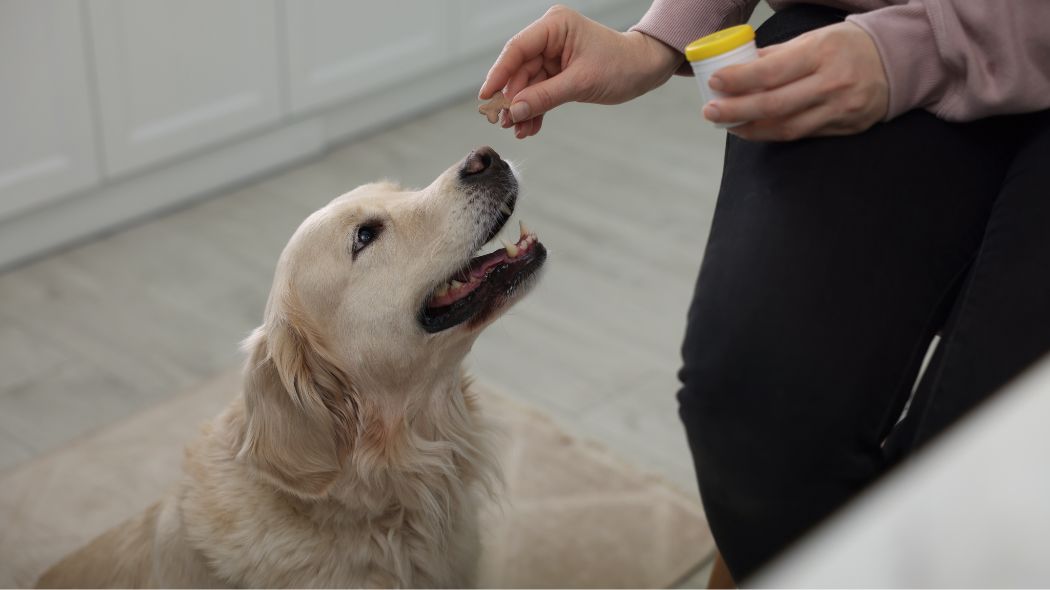the ultimate guide to flea prevention for dogs and cats
Keep fleas, ticks, and other parasites off your pets and away from your home before they become a problem.
Medically reviewed by Ari Zabell, DVM and Heidi Cooley, DVM

Prevent a flea infestation before it begins
Fleas can make life miserable for you and your pet. More than just an uncomfortable nuisance, fleas pose health risks for dogs, cats and humans. They can cause allergic reactions, skin irritations, and transmit diseases. Learn about flea-borne diseases
They’re also a headache for your home. Once fleas invade your space, it’s difficult to get rid of them. Take these steps to avoid getting fleas in the first place.

Vet recommended flea prevention
You can never fully control your pet’s environment or what they’ll get into, but you can make sure they’re always protected from fleas. Regular flea control is the easiest way to make sure your dog or cat stays parasite-free.
The different types of flea prevention
Before giving your furry friend medication, consult your vet to see which product is right for your pet and breed. While today’s flea products are safe and effective when used appropriately, some pets may have sensitivities. Certain diseases like epilepsy and other seizure/neurologic disorders warrant additional precautions.
Always use products as directed. Make sure to adhere to age, dosage, and weight guidelines. Not following the medication’s directions — such as splitting doses or using dog-specific medications on cats (or vice versa) — is less likely to solve the flea problem and could cause pets to become seriously ill.


Oral medications
These are pills or chewable tablets that your pet takes typically once a month. They enter your pet’s bloodstream and kill fleas when they bite and can disrupt the flea lifecycle. Oral medications are fast acting, easy to use, and available in combination with heartworm and tick prevention.
Vet recommended? Yes.
Duration: Up to 30 days.
Waterproof? Yes.
Caution: They may not be right for every pet.
Topical treatments (or spot-on)
These are liquid flea control solutions applied to your pet’s skin, typically from the neck along the back to the tail. The liquid absorbs into the skin and spreads across the body via the skin’s natural oils. These treatments kill fleas on contact, and some will also break the flea lifecycle.
Vet recommended? Yes.
Duration: May last up to 30 days.
Waterproof? Sometimes. Caution: Be careful applying this topical medication to dogs who live with cats (that might lick them) and also to pets that cuddle with babies. Always let the medication dry completely; it’s safe once fully absorbed.
Flea collars
These are easy and long-lasting but may not work as effectively as other options. They release insecticides and/or repellents slowly over time that spread through a pet’s skin and fur. Depending on the product, they may also be effective against ticks.
Vet recommended? Newer flea collars are safer and more effective than prior versions, so check with your vet.
Duration: Varies, but some may last up to 8 months.
Waterproof? No, but many are water resistant. More exposure to water lowers the lifespan of the product.
Caution: Not all flea collars are created equal.
Flea sprays, shampoos, and powders
These aim to kill fleas and parasites on contact as well as repel them for a short amount of time.
Vet recommended? Not usually. There are some situations when your vet might prescribe certain sprays, but the safety and reliability of other options is usually a better choice.
Duration: Must be used frequently.
Waterproof? No.
Caution: They must be reapplied frequently and are often not used alone.

Need advice on flea control? Ping Pet Chat™!
Whether it's 3 a.m. or 3 p.m., connect with a real veterinary professional for immediate petcare advice. It's included in all Optimum Wellness Plans®!
Log in to start chatting
Explore flea control at the Banfield Shop and save
The Banfield Shop carries a variety of vet-approved flea control options to keep your dog or cat parasite free. Sign up with AutoShip to never forget your pet’s flea medication and save 5%. Explore additional discounts on flea control with your pet’s Optimum Wellness Plan.
Avoid these natural home remedies for fleas
Some pet owners prefer to try “natural” flea remedies, like special food preparations, organic skin treatments, or homemade pesticides. However, none of these approaches are proven to control parasites — and some can actually be toxic for your cat or dog.
- Garlic is toxic and potentially fatal to some pets. Plus, there’s no scientific proof that garlic repels fleas.
- Essential oils on your pet’s fur is a bad idea. They are too concentrated for safe use, and they don’t help with the fleas.
- Traditional remedies like brewer’s yeast and herbs like pennyroyal and eucalyptus are sometimes promoted as good flea repellants. Unfortunately, pennyroyal is toxic to both pets and humans. And none of these “cures” have been shown to be particularly effective.
- Sonic repellents are often advertised as effective flea control, but they aren’t effective in eliminating potential parasites on pets. They also do not terminate pests in developing larval stages that may be growing around your home.
Easy things you can do to control fleas on dogs and cats
In addition to year-round flea control medication, limit your pet’s overall exposure to parasites. With warmer temperatures around the globe, fleas are moving into areas where they haven’t historically been. Keep an eye out for these pesky parasites.
- Keep pets away from where fleas live. Limiting exposure means being mindful of where you let your pets roam outdoors. Fleas can be found anywhere, but they thrive in warm, humid environments such as tall grass, shrubs, and shaded areas. Piles of leaves or mulch and under debris make ideal places for fleas to breed and even survive colder weather.
- Keep pets away from animals with fleas. Contact with wild and stray animals exposes your dog or cat to parasites. They can transfer between fur or simply by your pet being around where stray or wild animals spend time. Always monitor your pet’s interactions with wildlife.
- Check for fleas often. Catching fleas early can help prevent a bigger problem later. Inspect your pet around the neck, tail, and belly by parting the fur with your fingers and look for flea dirt, irritation, or redness. You can also use a flea comb to identify parasites and flea dirt. See how you can check for fleas
- Keep pets bathed and brushed. Brushing and bathing pets regularly removes loose fur, dander, and most flea eggs or larvae. This is a great time to check for fleas on your pet.

How to keep fleas out of your home
Fleas like to hang out in dark, warm places, and that means they want to move inside during winter. They’ll most likely want to catch a ride on your furry friend, so take the necessary steps outlined above.
Cleanliness is always a good policy. And even though it won’t prevent fleas from getting into your home, it can help them from multiplying and helps ensure you identify them sooner. Rugs, carpet, upholstery, bedding, and baseboards are easy places to lay eggs and avoid detection. Vacuum, sweep, and launder surfaces where your pet likes to hang out.

How to keep fleas out of your yard
Yards can become a breeding ground for fleas if not maintained and kept clean. You can’t realistically ensure all fleas are banished from your yard, but you can control things and minimize the threat of parasites. Here are simple steps to make it a safer place for your pets to play.
- Mow the lawn. Shorter grass is a less favorable environment for fleas. They prefer tall, shady, and moist grass where they can hide and breed. Cutting grass exposes the soil to more sunlight, making it drier and less appealing.
- Don’t over water. Fleas love damp, humid conditions. By not over watering, the ground will stay drier and less hospitable.
- Remove piles of leaves and junk. Take away the cool, dark, shady hiding spots that fleas love. Clearing out debris allows more sunlight and air circulation, making it less attractive for fleas to live and breed.
- Keep rodents and other animals away. Remove temptation by not leaving food out and keep trash and compost tightly sealed. Seal up holes around your home and clear away clutter.
- Spray for fleas and ticks. Many yard sprays can be toxic for pets and children. Contact a professional exterminator to address strategies and concerns to address fleas and other parasites in your yard.
Help keep your pet healthy and flea-free with Banfield
Parasites are one of the most common threats to your dog or cat’s health. Your vet team at Banfield can help create the right strategy for keeping them safe. It's important to consult a pet health professional to choose the right flea prevention for your pet’s age, breed, health needs, and lifestyle.
Get more care with an Optimum Wellness Plan
Banfield’s Optimum Wellness Plans covers all exam fees, so you can easily schedule a parasite check and discuss the best flea prevention options for your pet. Every OWP also includes 24/7 access to a veterinary professional who can answer your questions with Pet Chat™.
An Optimum Wellness Plan means you never have to worry about your dog or cat having access to the preventive care they need to help stay healthy. Learn more about OWP
 Mites and mange
Mites and mange Podcast - Not Just Fluff
Podcast - Not Just Fluff



